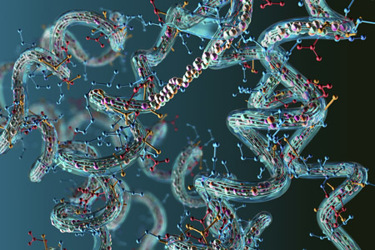Impurity Control Strategies For Therapeutic Peptides
By Julie Zhang, Ph.D., and Nikhil Rautela, M. Phil., USP

Peptides are an increasingly important class of molecules placed between the classic small organic molecules and the larger biomolecules. The number of FDA approved peptide drugs has shown a steady increase over the past 40 years.1 Therapeutic peptides are highly selective and efficacious, offer chemical and biological diversity, and have low toxicity. Most peptide drugs are manufactured using solid-phase peptide synthesis (SPPS) and increasing knowledge on the physiological function of peptides is driving peptide drug discovery to treat a range of conditions, including metabolic diseases, cancer, cardiovascular, hematological and infectious diseases, and pain.
The United States Pharmacopeial Convention (USP) hosted its annual workshop on Therapeutic Peptides and Oligonucleotides virtually on Feb. 28, March 2, and March 4, 2022. This year there were several presentations focusing on peptide impurity control strategies. This article summarizes the key points of these talks.
Synthetic peptide-related impurities can originate from raw materials, manufacturing processes, degradation during manufacturing or storage, and API-excipient interaction. These can potentially affect drug safety and efficacy and therefore must be characterized and controlled.
Starting Material Control Considerations
Incorporation of noncoded amino acids such as α-methyl amino acids in peptides can provide unique structural features to enhance stability and support the desired conformation and function. As the building blocks of the target peptide, α-methyl amino acids are considered as API starting materials and their quality should be carefully controlled. Compared with proteinogenic amino acids, α-methyl amino acids are more difficult to synthesize and less readily available, thus leading to high cost, long lead times, limited production capacity, loose specifications, and little available knowledge about their impurities. Mark Kerr from Eli Lilly presented a three-step approach to establish a long-term manufacturing solution using Fmoc-α-methyl amino acids. The first step is to work with a starting material vendor to establish a manufacturing process applicable to multiple α-methyl amino acids with sustainability and scalability. Second, the process is optimized by focusing on one α-methyl amino acid to further improve cost effectiveness and transferability. A backup vendor in another location is established and, lastly, the control strategy is set up with enhanced understanding of minor impurities.
Minimizing The Risk Of Nitrosamine Contamination Of Peptide APIs
Matteo Villain from Bachem described existing manufacturing risks of nitrosamine impurities forming from secondary amines (e.g., Nitroso-dimethyl-amine (NDMA), Nitroso-ethylisopropyl-amine (NEIPA), Nitroso-diisopropyl-amine (NDIPA), Nitroso-methyl-aminobutyric acid (NMBA), Nitroso-dipropyl-amine (EP only) (NDPA), Nitroso-diethyl-amine (NDEA), Nitroso-phenylmethyl-amine (NMPA), and Nitroso-dibutyl-amine (NDBA)) in the presence of nitrosating agents (e.g., nitrites, salts), high temperature, and acidic conditions during production processes.
To control the potential risks of the manufacturing process generating nitrosamine impurities, a control strategy is required during process development such that any potential cause for nitrosamine formation or contamination is minimized to an acceptable level. Failure modes and effects analysis (FMEA) is an ideal approach to conduct this type of complex, multiparameter risk analysis. FMEA includes a qualitative questionnaire and distinguishes the following failure modes for nitrosamine contamination:
- amine structures in reagents and starting materials
- risk of nitrite contamination in reagents and starting materials
- risk of direct nitrosamine contamination in or by reagents, starting materials, secondary reactions, or product contact surfaces
FMEA for each individual product is based on ICH Q9 (Quality Risk Management) and ICH M7(R1) (Mutagenic Impurities), where the risk of nitrosamine in the final API is dependent on three parameters:
- probability of failure mode (PRN FM)
- probability of having nitrosamines resulting from failure mode (PRN NA)
- probability that resulting nitrosamines are carried into the API (PRN API)
The severity of each individual failure mode is described by severity number (SN) = PRN FM x PRN NA.
The risks for individual failure modes are defined by their risk number (RN) = SN x PRN API, which are then further categorized as (i) no risk, (ii) very low risk, (iii) low risk, (iv) medium risk, and (v) high risk, with appropriate action required for each.
Bachem’s FMEA methodology further recommends forming a FMEA panel (product specific and site specific) comprising SMEs from the manufacturing unit with expertise in the product under evaluation, members of the QA unit, and members of the procurement unit as needed, where the panel’s preliminary activities are to:
- Establish the origins of reagents at each facility (each FMEA is product and manufacturing facility specific).
- Generate a bill of materials specific for the product and obtain manufacturer statements for materials on their potential risk to contain nitrosamine, nitrates, or other precursors where questionable.
- Review any internal product and processes for use of nitrites at the site. Review existence of these reagents in the EPR system.
- Evaluate and judge the potential of the SPPS washing steps as well as of the preparative HPLC purification steps to prevent carryover of nitrosamine impurities into the final API.
There is an increasing need to quantify nitrosamines, and with different manufacturers testing their own methods, Bachem developed a testing method appropriate for quantification of nitrosamines of concern in final APIs - GC-MS/MS, adapted to a head space injection (“Procedure C” of European Pharmacopeia chapter 2.5.42, “N-Nitrosamines in active substances”). It was generically validated for the following nitrosamines: NDMA, NEMA, NDEA, NEIPA, NDIPA, NDPA, and NDBA with initial validation tests and established limits of quantitation (LOQ) in an acceptable range. However, for each API, a specific validation or verification may be necessary (including limits of detection [LOD] and LOQ) to evaluate the effect of the API in the sample matrix.
Other suggestions to reduce the risk of contamination included:
- Regularly using preparative HPLC to reduce the risk of nitrosamine carryover into the API by identifying them early.
- Using fresh reagents and solvents avoids potential contamination risks that may come with recycling processes.
Characterization Of D-amino Acid Impurities
D-amino acids can be formed during synthesis and storage, especially for some amino acids that have a relatively high tendency for racemization. The presence of D-amino acid can also influence the biological activity of peptide molecules. Therefore, the control of D-amino acid impurities is critical but can be challenging for low-level impurities. The FDA guidance ANDAs for Certain Highly Purified Synthetic Peptide Drug Products that Refer to Listed Drugs of rDNA Origin, which covers five peptide drug products (glucagon, liraglutide, nesiritide, teriparatide, and teduglutide), recommends applicants should identify any peptide-related impurity that is 0.10% of the drug substance or greater for the covered peptides.
Baole Zhang from Hybio Pharmaceutical introduced a four-step characterization method for D-amino acid impurities, which includes the hydrolysis of the peptide in deuterated hydrochloric acid to differentiate the racemic amino acids from non-racemic amino acids by deuterated or non-deuterated amino acids, followed by chiral derivatization of these amino acids and detection by LC-tandem HRMS. Zhang discussed the challenges they faced to quantify the D-amino acid impurities in semaglutide. They found that direct analysis of the low-level D-amino acids is unsuitable. By applying substrate (both API and the corresponding D-amino acid impurity standard can be used as the substrate), direct characterization of low-level D-amino acid degradation impurities became more feasible. The methodology was used successfully to characterize D-Ser, D-His, and D-Asp degradants in semaglutide.
Case Study: Tirzepatide
Large-scale manufacturing of complex peptides has manufacturing risks and challenges with generally low yields and purities. Mark Strege from Eli Lilly discussed a hybrid approach of SPPS and liquid-phase peptide synthesis (LPPS) methodologies, which integrates the best elements of small and large molecule processes, leading to significant improvements in the control strategy relative to a linear approach. He shared a case study for this approach that was used to synthesize tirzepatide, a novel dual glucose-dependent insulinotropic polypeptide (GIP) and glucagon-like peptide-1 (GLP-1) receptor agonist intended for use in patients with type 2 diabetes. It is 39 amino acids long, with a C20 fatty acid chain attached at Lys 20 and a MW of 4,810.53 kDa. The API is isolated in solid form and then reconstituted.
The key control points to ensure quality in this hybrid model were:
- Raw material (Fmoc-amino acids) purity specifications
- Stoichiometric controls for activation, coupling, and deprotection
- Parametric control ranges including temperature, time, and solvent volumes
- In-process controls to ensure reaction completion and reagent removal
For tirzepatide fragments, UHPLC-UV is the primary platform for analysis, while UHPLC-MS can be used as a complementary orthogonal method for subsets of co-eluting impurities (co-elution with main peak and other impurities). However, the UHPLC-MS requires a reference standard for each impurity.
USP Peptide Standards And Next Steps
USP provides documentary standards and reference standards to support the quality of medicines. In 2020 when the new USP Expert Committees reformed, the Biologics Monographs 1 Expert Committee (BIO1 EC) was commissioned to continue its commitment to peptide standards. Julie Zhang from USP presented the existing peptide standards, the recent activities, and the work plan for peptides. Since 2020, the new BIO1 EC has approved a new general chapter, <1503> Quality Attributes of Synthetic Peptide Drug Substances, approved revisions of four documentary standards (Glucagon, Glucagon for Injection, <123> Glucagon Bioidentity Tests, and Teriparatide) and proposed the following to Pharmacopeial Forum (PF) for public revisions:
- A new general chapter <1504> Quality Attributes of Starting Materials for the Chemical Synthesis of Therapeutic Peptides. This proposed chapter provides guidance on the minimum quality attributes for starting materials used in the manufacture of synthetic therapeutic peptides. The public comment period has closed and the Expert Committee is now resolving the public comments received before determining if the chapter can ballot to move to official.
- Two new monographs: Bivalirudin and Bivalirudin for Injection
- Revision of Glucagon monograph for the addition of tests for synthetic glucagon
Revisions of the Gonadorelin Acetate monograph and five new monographs are in the future work plan of BIO1 EC, including Eptifibatide, Triptorelin Pamoate, Ganirelix Acetate, Ganirelix Acetate Injection, and Icatibant Injection. Several new peptide reference standards relevant to bivalirudin, gonadorelin, and eptifibatide were approved by BIO1 EC to support the corresponding monographs.
USP is actively seeking sponsors and submissions to develop standards for additional new peptide products. Sponsors for liraglutide, linaclotide, carfilzomib, and others are sought. Peptide stakeholders are encouraged to contact Julie Zhang at julie.zhang@usp.org to participate in standard setting activities.
References
- Muttenthaler, M., King, G., Adams, D., Alewood, P., Trends in peptide drug discovery. Nature Reviews Drug Discovery, 20: 308-325.
 About The Authors:
About The Authors:
Julie Zhang, Ph.D., is a team leader in USP’s Global Biologics Department. Her group is responsible for documentary standard development for a variety of products from peptides, proteins, and antibiotics to complex biologics.
 Nikhil Rautela, M.Phil., is a senior scientific affairs manager for biologics at USP India. His primary role is to engage with stakeholders to advocate for the quality of USP science supporting biologics as well as peptides and oligonucleotides.
Nikhil Rautela, M.Phil., is a senior scientific affairs manager for biologics at USP India. His primary role is to engage with stakeholders to advocate for the quality of USP science supporting biologics as well as peptides and oligonucleotides.
